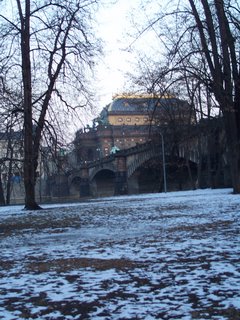
Janacek and Jenufa
Premiered: Prague, May 26, 1916
Libretto after Gabriela Preissová
German text by Max Brod
Janacek was living in Brno during the composition of Jenufa or Její pastorkyňa
which was first premiered there in 1904. Janacek sent the score to Karel Kovařovic and Gustav Schmoranz with hopes of premiering the work at the National Theater in Prague. The conductor-composer, Karel Kovařovic was in charge of the opera direction at the time. When Janacek wrote a cutting review of Kovařovic’s opera Ženichové / The Bridegrooms premiere in Brno, he created future conflicts for his own works to be performed in Prague. Kovařovic accepted Jenufa only after lengthy application from Janacek and the intervention of Gustav Schmoranz and Marie Calma-Veselá, the soprano who later sang the title role in the Prague premiere of May 26, 1916.
One story is that Director Schmoranz and the writer, Šípek-Peška were walking together when they heard a soprano singing. Curious about the unknown piece, they stopped and inquired by which Marie Calma-Veselá introduced the Jenufa’s famous prayer to the Virgin from the Second Act of Jenufa. Eventually Schmoranz was persuaded to take on Jenufa for the National Theater, but the performance was accepted on provision that Kovařovic had control over the orchestration.
When Janacek learned of its acceptance, he went in search of a soprano to sing the Kostelnicka and recruited Gabriela Horvátová who was in Brno for performance. Already an opera of domestic chaos, the conflicts grew within Janacek’s domestic and professional life. When he met Horvátová at her hotel and was received by her in bed. This characterized their relationship as it moved from Brno to Prague in preparation of the premiere while he became further estranged from his wife.
The libretto was written after a play by Mrs Gabriela Preissová, Her Stepdaughter. Zdenka and Leos Janacek had two children, Vladimir and Olga, but both died in childhood. Zdenka was just short of sweet sixteen when she married Janacek in 1881. She bore Olga in 1882 and had Vladimir in 1888. Vladimir died of scarlet fever when he was two in 1890 and Olga died in 1903. The bitter loss is reflected in the musical composition. Janacek moved from set structure of opera which introduced arias with recitative to what he called, Sprachmusik, shaping the musical line around speech patterns and having the orchestra mimic speech. This is particularly effective in the characterization of the Kostelnicka in contrast to Jenufa who retains her idealism in the face of her stepmother’s bitterness. Jenufa also brought Czech nationalism onto stage as it concentrated on domestic life rather than mimicking Italian or German opera with the import of another French novel set as a libretto.
The Viennese premiere came on February 18, 1918 at the Hofoper with Maria Jeritza. Janacek’s affair with Horvátová ended, but another began and continued with Kamila Stösslová. Jeritza also sang the title role, Jenufa for the Metropolitan premiere in New York in 1924. The German text was translated by Max Brod. Controversy surrounds the opera regarding which production to follow, Brno 1904 or Prague 1916.
Jenufa / Její pastorkyňa
http://www.leosjanacek.co.uk/jenufa.htm
Leoš Janaček
http://www.leosjanacek.co.uk/
biographical site
Link Page
http://www.leosjanacek.co.uk/links.htm
Classical Music Pages- Leoš Janaček
http://w3.rz-berlin.mpg.de/cmp/janacek.htm
Classical Net- Janacek
http://www.classical.net/music/comp.lst/janacek.html
John Tyrell, biographer
http://www.czechmusic.co.uk/
for books on Janacek
Janacek Association in Japan
http://www2.snowman.ne.jp/~hyamane/indexenglish.htm
Leos Janacek Gesellschaft
http://www.leos-janacek.org/
http://www.leos-janacek.org/nav/3fentry.htm
Janacek Archive and Museum in Brno
http://www.sun.rhbnc.ac.uk/Music/Janacek/
Leos Janacek as a Teacher
http://w3.rz-berlin.mpg.de/cmp/janacek_teacher.html
Open Directory Janacek
http://dmoz.org/Arts/Music/Composition/Composers/J/Jan%c3%a1cek,_Leos/


